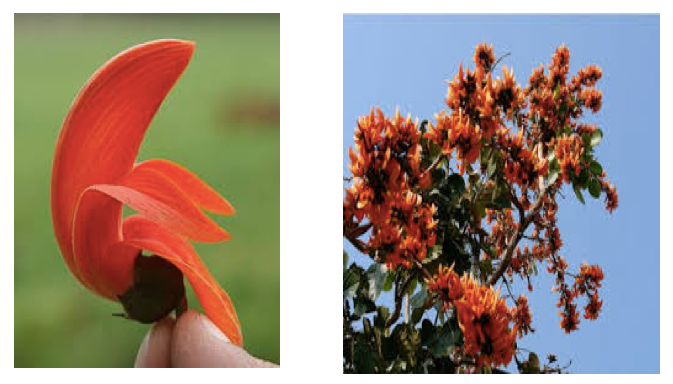[Originally published as part of my Column “Green Cardamoms “ in Shillong Times, Canvas, page 3].
The Flame of the Forest or Palasa
Author: Gaurangi Maitra

Photo credits: www.wikipedia.org & www.alibaba.com
Memory tags: Cutting chai under the Palash when Shyambati, Santiniketan was just a one shop destination
Just beyond the university campus, as the road wound down to the canals stood our favorite teashop. Housed under a thatched roof with a mud stove and wooden benches for its clientele, it was our own tea house. The brew never varied, strong warm dark brown red brew strained through a blackened ancient strainer. Thick . ribbed , small glasses were rinsed out with hot water before the “special” brew could be handed out. I always preferred the earthy flavour of the earthen tea cups or matkas. Across the road under the large peepal often sat fellow students with sketch pads and pencils. It was in winter and spring that our tea house would have a background that any luxury hotel would pay a king’s ransom for! In winter the jheel in the background would be full of migratory birds. In spring the area in the foreground would be a carpet of flaming orange coloured blossoms! The ash coloured trunk of the tree rose up 10 to 15 meters into the blue March sky. High up on this trunk would be the cloud of bright red orange from where the blossoms had dropped. A dark brown velvety cup held each long, silky flower. When the flowers are bunched together in full bloom, there are almost no leaves to break this sea of vermillion!
While sipping tea with our friend and storyteller one summer evening, the temperature suddenly dropped, the darkened sky was ripped apart by lightening, behind the palasa! The unannounced summer storms brought welcome rain! The hot tea would tasted sweeter now, especially after we had bitten into a sizzling hot, savoury potato “chop”. This, our storyteller said, biting into one could be an Anglo – Indian legacy that may have began its journey on 23 June 1757 at Palashi, West Bengal, when the British won the Battle of Plassey. Its Commander Colonel Robert Clive later became not only Governor of Bengal but Baron of Plassey! Both the rain and story continued to fill us in with fact , legend and custom.Legends tell us these flaming blossoms are a form of Agnidev, God of Fire ! Glistening sunbirds, sleek black drongos and bulbuls, flit play among its flowers and branches. Garlands gather these flowers into jewellery for hair, hands and neck during the spring festival of colour, Holi or Dol, in Tagore’s Santiniketan.
By the of April there would be no more blossoms left and pale green flat pods would cover the whole tree. Then, green large trifoliate leaves clothed the tree till December, when it would again become leafless. Over another round of tea, we are told the trifoliate leaves are taken to represent the holy triumvirate of Brahma, Vishnu and Shiva. Its wood, bark, flowers find use in the scared and medicinal, wherever this tree grows in eastern, tropical Asia. The troubadour remembered how utensils and staff made from its wood are used in both the Brahmin thread ceremony and when a person becomes a sanyasi. The rain had stopped, but the bard went on ...
This tree was frequently mentioned in the Vedas and Amir Khusru had compared the palasa blossoms to lions claws stained in blood ! In the modern scientific world, it is named Butea monosperma . The first name a tribute to the British Prime minister and botanist after John Stuart, 3rd Earl of Bute, ( 1713 - 1792), whose botanical work Botanical Tables Containing the Families of British Plants was published in 1785. The second name refers to the single seed within its pod. The bard got up, and promised to meet us again with another story another time.
Main references:
- Blatter & Millard, “Some Beautiful Indian Trees” Bombay Natural History Society Publication,1977
- Butea monosprema, GRIN,ARS, USDA.
- Wikipedia
